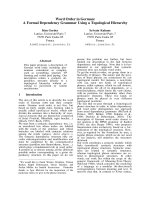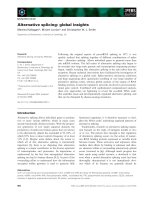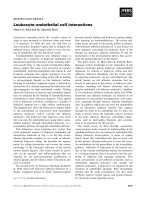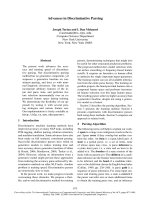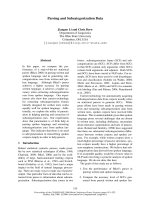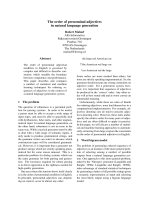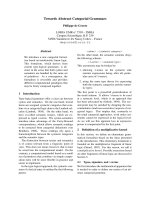Báo cáo khoa học: "FRENCH ORDER WITHOUT ORDER" pot
Bạn đang xem bản rút gọn của tài liệu. Xem và tải ngay bản đầy đủ của tài liệu tại đây (539.78 KB, 7 trang )
FRENCH ORDER WITHOUT ORDER*
Gabriel G. B~
Universit6 Blaise Pascal - Clermont II, Formation Doctorale Linguistique et Informatique
34 Ave. Carnot, 63037 Clermont-Ferrand Cedex, FRANCE
Claire Gardent
Universit6 Blaise Pascal -Clermont II and University of Edinburgh, Centre for Cognitive Science,
2 Buccleuch Place, Edinburgh EH89LW, SCOTLAND, UK
ABSTRACT
To account for the semi-free word order of French,
Unification Categorial Grammar is extended in two
ways. First, verbal valencies are contained in a set
rather than in a list. Second, type-raised NP's are
described as two-sided functors. The new framework
does not overgenerate i.e., it accepts all and
only the
sentences which are grammatical. This follows partly
from the elimination of false lexical ambiguities - i.e.,
ambiguities introduced in order to account for all the
possible positions a word can be in within a sentence -
and partly from a system of features constraining the
possible combinations.
INTRODUCTION
In the version of categorial grammar (henceforth,
CG) developed by Bar-Hillel (Bar-Hillel 1953), cate-
gories encode both constituency and linear prece-
dence. Linear precedence is encoded by (a) ordering
valencies in a list and (b) using directional slashes
indicating whether the argument is to be found to the
left or to the right of the functor.
A similar approach is adopted in Unification Cate-
gorial Grammar (UCG) (Zeevat, Klein and Calder
1987) as regards word order whereby the directional
slash is replaced by a binary
Order
feature with value
pre orpost.
Thus, S/NPLNP in normal CG lranslates as
S/NP:predNP:post in UCG,
wherepre
indicates that the
functor must precede the argument and
post
that it
should follow it.
Our work on French syntax supports the claim that
the complicated pattern of French linearity phenomena
can be treated in a framework closely related to UCG
but which departs from it in two ways. First, there is no
rigid assignment of an order value
(pre orpost) to
verb
valencies. Second, following (Gunji 1986) verbal va-
lencies are viewed as forming a set rather than a list. As
* The word reported here was tan'led out as part of ESPRIT
Project 393 ACORD,'q'he Construction and Interrogation of
Knowledge Bases using Natural Language Text and Gra-
pities".
a result, the syntactic behaviour of constituents is
dissociated from surface ordering. Constraints on
word order are described by a system of features as
advocated in COszkoreit 1987) and (Karttunen 1986).
1.
UCG
In UCG, the phonological, categorial, semantic and
order information associated with a word is contained
in a single grammar structure called a
sign. This can be
represented as follows.
(1) UCG sign
Phonology:Categnry:Semantics:Order
or equivalently
Phonology
:Category
:Semantics
:Order
where colons separate the different fields of the sign.
We need not concern ourselves here with the
Se-
mantics and the Phonology
fields of the sign. More
interesting for our purpose are the
Category and the
Order
attributes. Following the categorial tradition,
categories can be basic or complex. Basic categories
are of the form
HeadAFeatures
where
Head
is one of
the atomic symbols n(oun),
np
or s(entence) and
Fea-
tures
is a list of feature values. Complex categories are
of the form
C/Sign,
where C is either atomic or com-
plex and
Sign
is a sign, so that departing from traditio-
nalCG's,a functorplaces constraints on the whole sign
of the argument rather than on its syntactic category
only. The part of a complex category which omits the
Head'Weatures
information constitutes the
activepart
of the sign. The f'trst
accessible sign
in the active part
is called the
active sign, the
idea being that e.g. verb
valencies are ordered in a list so that each time a
valency is consumed, the next sign in the active part be-
comes the new active sign. The
Order
attribute places
constraints on the combination rule that may apply to
a functor:
pre
on an argument sign Y indicates that the
functor X/Y must precede the argument, while
post
indicates that the functor must follow the argument.
- 249-
Using terms and term unification, the forward version 1
of functional application can then be stated as follows.
(2) Forward Application
Functor
PhonologyF
:CategoryF/PhonologyA
: CategoryA
: SemanticsA
:prc
:SemanticsF
:OrderF
Argument
PhonologyA
:
CategoryA
: SemanticsA
: pie
Result
PhonologyF PhonologyA
:CategoryF
:SemanticsF
:OrderF
were upper letters indicate Prolog variables. In effect,
the rule requires that the active part of the functor sign
term unifies with the argument sign. The Result is a
sign identical to the functor sign, but where the com-
plex category is stripped from its active part and where
variables shared by the active part of the functor and the
rest of the functor sign may have become ground as a
result of the active part unifying with the argument.
The resulting phonology consists of the phonology of
the functor followed by the phonology of the argument.
An illustrative combination is given in (3) below for
the sentence Jean marche.
(3) Derivation of Jean marche
jean ¸
: C/__ I
:(C/(_:np:jean':O)
:S
=:~
marche [
: s^[fin]/(_.:np:X:pre)
: marche'(X)
2_
jean marche
:s^[fm]
:marche'(jean~
;_
where lines represent the information flow determi-
ning ordering : shared variables ensure that pre in a
verb valency constrains the fanctor NP that consumes
this valency to precede the verb carrying this valency.
2. LINGUISTIC OBSERVATIONS
Word order in French is characterised by three main
facts. First, the positioning - left or right- of a particular
argument with respect to the verb is relatively free. As
t. Baekward application is just the symmetric of (2) where the
argument precedes the funetor endpre becomes post.
illustrated in (4), the subject can appear to the left (4a)
or to the right (4b,c) of the verb, or between the
auxiliary and the verb (4d), depending on the morpho-
logical class of the NP and on the type of the sentence
(declarative, subject-auxiliary inversion, wh-question,
etc).
(4) (a) Jacques aime Marie.
CO) Alme-t-il Marie ?
(c) Quel livre aime Jacques ?
(d) A-t-il aim6 Marie ?
All other arguments can also appear to the left or to
the right of the verb under similar conditions. For
example, a lexical non-nominative NP can never be to
the left of the verb, but critics and wh-constituents can.
(5) (a) *Marie aregard~e Jacques ?
(with Marie = Obj)
Co) QueUe revue a regard~e Jacques ?
(with Quelle revue = Obj)
(c) Jacques l'a regardte
Second, there seems to be no clear regularities go-
verning the relative ordering of a sequence of argu-
ments. That is, assuming that only adjacent consti-
tuents may combine and taking the combinations left-
to-right, the combination pattern varies as indicated
below of each example in (6). Here again, the permis-
sible distributions are influenced by factors such as the
morphological class of the constituents and the verb
mood.
(6) (a) Pierre donne h Marie un livre.
[Subj,IObj,Obj]
Co) Pierre donne un livre h Marie.
[Subj,Obj,IObj]
(c) Le lui donne-t-il ?
[Obj,IObj,Subj]
(d) Se le donne-t-il ?
[IObj,Obj,Subj]
Third, coocurrence restrictions hold between cons-
tituents. For example, clitics constrain the positioning
and the class of other arguments as illustrated in (7) 2
(7) (a) Pierre le lui donne.
Co) Pierre lui en donne.
(c) Pierre lui donne un livre.
(d) *Pierre lui le donne.
(e) *Pierre lui y donne.
Since the ordering and the positioning of verb
arguments in French are very flexible, the rigid orde-
In italics : the word whose coocurrence restriction is
violated (starred sentences) or obeyed (non-starred senten-
ces). For instance, (7d) is starred because lu/may not be
followed by le.
- 250-
ring forced by the UCG active list and the fixed
positioning resulting from the Order attribute are ra-
ther inadequate. On the other hand, word order in
French is not free either. Rather it seems to be governed
by conditional ordering statements such as:
(8) IF (a) the verb has an object valency, and
Co) the object NP is a wh-constituent, and
(c) the verbal constituent is the simple inflected
verb, and
(d) the clitic t-il/elle has not been incorporated
THEN the object can be placed to the left or to the
right of the verb.
If say, (8d) is not fulfilled, the wh-NP can be placed
only to the left, witness: *Jacques a-t-il regard~ quelle
revue ?, and mutatis mutandis for the other conditions.
More generally, five elements can be isolated whose
interaction determine whether or not a given argument
can occupy a given position in the sentence.
(9) (a) Position - left or right - with regard to the
verb,
Co) Verbal form and sentence type,
(c) Morphological class (lexical, wh-consti-
tuent or clitic) of the previous constituent
having concatenated to the left or to the right
of the verb,
(d) Morphological class of the current consti-
tuent (lexical, wh-constituent or clitic),
(e) Case.
We claim that it is possible to extend UCG in order
to express the above conditioning variables. The resul-
ling grammar can account for the preceding linguistic
facts without resorting either to lexical ambiguity or to
jump rules 3.
3. EXTENSIONS TO UCG
To account for the facts presented in section 2,
UCG has been modified in two ways. Firstly, the active
part ofaverb category is represented as a set rather than
a list. Secondly, a feature system is introduced which
embodies the interactions of the different elements
conditioning word order as described in (9) above.
3.1 SIGN STRUCTURE AND COMBINATION
RULE : FROM AN ACTIVE LIST TO AN
ACTIVE SET.
To accomodate our analysis, the sign structure and
the combination rule had to be slightly modified. In the
French Grammar (FG), a sign is as follows.
XA jump rule as used in (Baschung et al. 1986), is of the form
X/Y, Y/'Z
=> X/'Z.
(10)
French Grammar Sign
Phonology
: Category
: Features
:
Semantics
: Optionality
: Order
Semantics and Phonology are as in UCG. Optiona-
lity indicates whether the argument is optional or
obligatory 4. The Category attribute differs from UCG
in that (i) there are no Features associated with the
Head and (ii) the active part of a verb is viewed as a set
rather than as a list.
The Features attribute is a list of features. In this
paper, only those relevant to order constraints are
mentioned. They are: case, verb
mood,
morphological
class of NP's (i.e., lexical, clitic or wh-constituent)
and last concatenation to the left
(Lastlefl)
or to the
right
(Lastright). The
latter features indicate the mor-
phological status of the last concatened functorand are
updated by the combination rule (cf. (13)). For ins-
tance,
the sign associated with Jean lui a donnd un livre
will have lex as values for Lastlefl and Lastright
whereas lui a donn~ un livre has lui and lex respective-
ly. The Features attribute can be represented as in (11 )
below, where the same feature may occupy a different
position in the feature list of different linguistic units,
e.g., feature list of verb valencies and feature list of NP
signs.
(11) The Features attribute
For valencies (active sign of NP's and verbs) :
[Case, Lastleft, Lastright]
For verb signs :
[Mclass, Lastleft, Lastright, Vmood]
As illustrated in (12), the Order attribute has two
parts, one for when the functor combines forward, the
other for when it combines backward.
(12) The Order attribute
Cdts =~ pre ~ Resfeat,
Cdts =~ post =~ Resfeat,
where Cdts and Resfeat are lists of feature values
whose order and content are independent from those of
the Features attribute. The intuition behind this is that
functors (i.e., type-raised NP's) are two-sided i.e., they
can combine to the left and to the right but under
different conditions and with different results. The
features in Cdts place constraints on the features of the
argument while the features in Resfeat are inherited by
the resulting sign. These effects are obtained by unifi-
4. In the rest of this paper, the Semantics and the Optionality
attributes will be omitted since they have no role to play in our
treatment of word order while Phonology will only be repre-
sented when relevant.
- 251 -
cation of shared variables in the rules of combination.
Omitting Semantics and Optionality attributes, the
forward combination rule is as follows.
(13) Forward Combination s (FC)
Functor
PhonologyF
:~ CategoryF / PhonologyA
:CategoryA
:[MClassA ]
: ([Lastleft,Vmood] ~pre~ [Vmood2],
_3
:[MClassF ]
."
Argument
PhonologyA
:[] CategoryA'
: [MClassA,Lastleft,Lastright,Vmood]
{combine ([]], [21, Category')}
Result
PhonologyF PhonologyA
: Category'
: [MClassA, MClassF, Lastright, Vmood2]
The rule requires (i) that the functor category
combines with the argument category [] to yield the
result category Category'. The notion of combination
relies on the idea that the active part of a verb is a set
rather than a list. More precisely, given a type-raised
NP NP1 with category C/(C/NP.) where NP i is a
valency sign, and a verb V1 with category slActSet
where ActSet is a set of valency signs, NP1 combines
with V1 to yield V2 iff NPi unifies with some NP-valen-
cy sign in the active set ActSet of the verb. V2 is
identical to V1 except that the unifying NP i valency
sign has been removed from the active set and that
some features in V1 will have been instantiated by the
rule. Forward combination further requires (ii) that the
two features in the condition list to pre unify with the
Lastlefl and Vmood features of the argument (the fea-
tures conditioning post are ignored since they are rele-
vant only when the functor combines backwards), and
(iii) that the features of the resulting sign be as speci-
fied. Note in particular that the MClass of the resulting
sign is the MClass of the argument, that Lastright
which indicates the morphological class ofthelast sign
to have combined with the verb from theright, is trans-
mitted from the argument, and thatLastlefl is assigned
as value the MClass of the functor. Features of the re-
suiting sign which are conditional on the combination
order ate inherited from the Resfeat field. This perco-
x In this figure, numbers inside square denote the following
attribute. For instance, [] denotes CategoryA'.
lation of features by rule is crucial to our treatment of
word order. It is illustrated by (14) below where the
sign S 1 associated with the clitic le combines with the
sign for $2 regarde to yield a new sign $3 le regarde.
(14) Derivation of le regarde
S1 le
:C/(C/(np:[obj ]:-3
:[obj ]
:-3
:[vb ]
:(tiui or i, ind] => pre => [ind],
[i, imp] =>post => [imp])
:tie
]
:_
$2 regarde
:s/{ np , np }
:[obj ] :[subj ]
:[vb, i, i, ind]
:_
$3 le regarde
:s/t nP }
: [subj ]
:[vb, le, i, ind]
:_
When le is used as a forward functor, the conditions
on pre require that the argument i.e., the verb bears for
the feature Lastlefl the value lui or i where i stands for
initial state thus requiring that the verb has not combi-
ned with anything on the left. When it combines by BC,
the conditions onpost ensure that the argument has not
combined with anything on its right and that it has
mood imperative. In this way, all sentences in (15) are
parsed appropriately.
(15) (a) I1 le hi donne.
Co) *II lui le donne.
(c) Donne le lui.
(d) *Donne lui le.
The backward combination rule (BC) functions
like FC except for two things. First, the argument must
be to the left of the functor and second, the condition
field considered is that ofpost rather than ofpre. There
is also a deletion rule to eliminate optional valencies.
No additional rule is needed.
3.2 EXPRESSING THE VARIABLES UNDER-
LYING WORD ORDER CONSTRAINTS
In our grammar, there are nopost andpre primitive
values associated with specific verb valencies. Instead,
features interact with combination rules to enforce the
- 252 -
constraints on word order described in (9). (9a) is
captured in the two-sided order field. (9b - verb mood)
and (9c- morphological class of preceding concatena-
ting functor) are accounted for in that in a functor, the
features conditioning order include the verb mood and
the last concatenation attribute.
(9d) is accounted for in that
conditions which are
invariant for a particular class of constituent
(clitic,
wh-constituent, lexical NP) are expressed in the Order
field of these constituents. For example, wh-consti-
tuents reject through their conditions
topre
a wh-value
for the
Lastlefl
feature of the argument and an
inv16
value in their condition to
post.
As a result, the follo-
wing sentences are parsed appropriately.
(16) (a) *A qui qui a ttltphon6 ?
Co) *A-t-il t~ltphon6 a qui ?
(c) A qui a-t-il ttltphon6 ?
(d) I1 a ttltphone a qui ?
Conditions which vary depending on the class of
the concatenating constituent are
expressed in the
Features
attribute of the verb valencies. This allows us
to express constraints on the position of a given type of
NP (lex, wh or clitic) relative to the valency it consu-
mes. For instance,a lexical NPcan be subject or object.
If it is subject and it is to the left of the verb, it cannot
be immediately followed by a wh-constituent. If it is
subject and it is placed to the right of the verb, it must
be immediately adjacent to it. These constraints can be
stated using unification along to the following lines.
A verb valency is of the form
(17) (np:[ X,Y ]:Ord)
where X and Y are either the anonymous variable or a
constant. They state constraints, among others, on
possible values
ofLastlefl andLastright
features of the
verb. Recall that a valency is a sign which is a member
of a set in the
Category
attribute of a verbal sign.
The active sign of a type raised NP is of the form:
(18) C/(np:[ V1, V2 ]:__)
:[vb I_]
:([V1 ] => pre => Z, [V2 ] => post => W)
By rule, V1 and V2 in the
Category
attribute of (18)
must unify with X and Y, respectively, in the verb
valency (17). Being shared variables, they transmit the
information to the
Conditions
on concatenation by FC
(pre) and BC (post), respectively.
Furthermore, V1 and V2 in the
Ord
attribute of the
functor must unify, by rule, with some specified featu-
res in the verb
Features
attribute represented in (19).
The value/nvl for the
Lastlefl
feature of a verb resulm from
a backward combination of the nominative elitic
-t-il
with
this verb.
(19) [vb, Lasleft, Lastright ]
The flow of information between (17), (18) and
(19) is represented graphically in (20), where (20a),
(20b) and (20c) correspond to (17), (18) and (19) res-
pectively. (20a) and (20c), which express the
Category
and theFeatures
attibutes of the same verbal sign, have
been dissociated for the sake of clarity.
(20) Flow of information between functor and argu-
ment
(a)
(np:[ :~,~' ]:Ord)
CO) ]: _3
C/(np:[ V1, V2
:([V1 ] ~ pre=~ Z, [V2 ] =~ post =:~W)
(c) [vb,'~tleft, t
Lastright ]
:fwd; :bwd
For example, suppose the nominative valency
(21a), in the verbal sign
tdMphone d la fille,
whose
Features
attribute is as in (21c), and the lexical sign
Jean
(21b).
(21) Flow of information
between Jean and tdldphone
a laJ#le
(a)
(np:tnom -:wh, i ]:Ord)
I I
1 I
Co) C/(np:[nom or obj V1, V2 ]:_ )
:[vb I
:([V1 ] ~ pre=~ Z,[~V2 ] =~ post =~ W)
(c) :[vb, i, lex,'~ ]
The concatenation by FC is allowed
(-wh
is com-
patible with 0, the requirement extracted from the
verbal valency being that the Lastleft concatenated
contituent with the verb is not a wh-constituent. But a
concatenation by BC will fail(i does not unify with
lex).
Thus examples in (22) are correctly recognised (see
Appendix).
(22) (a) Jean ttltphone ~t la Idle.
Co) *Ttltphone ~ la fille Jean.
(c) *Jean ~ quelle fille ttltphone ?
(d) A queUe fille ttltphone Jean ?
4. IMPLEMENTATION
The UCG formalism and the corresponding com-
putational environment were developped at the Centre
for Cognitive Science, University of Edinburgh by
(Calderetal. 1986). They include facilities for defining
templates and path-equations as in PATR-2 and a shift-
reduce parser. The extensions to the original frame-
work have been implemented at the Universit6 Blaise
- 253
-
Pascal, Formation Doctorale Linguistique et Informa-
tique, Clermont-Ferrand (France). The system runs on
a Sun and has been extensively tested.
5. COVERAGE AND DISCUSSION
The current grammar accounts for the core local li-
nearity phenomena of French i.e., auxiliary and clitic
order, clitic placement in simple and in complex verb
phrases, clitic doubling and interrogative inversions.
Unbounded dependencies are catered for without re-
sorting either to threading COCG), functional uncer-
tainty (Karttunen) or functional composition (Combi-
natory Categorial Grammar, Steedman 1986). Instead,
the issue is dealt with at the lexical level by introducing
an embedding valency on matrix verbs. Finally, non
local order constraints such as constraints on the distri-
bution of negative particles and the requirement for a
wh-constituent to be placed to the left of the verb when
a lexical subject is placed to the right (see example
(22d)) can also be handled.
Thus, it appears that insights from phrase structure
and categorial grammar can be fruitfully put together
in a lexical framework. Following GPSG, our forma-
lism does not associate verb valencies with any intrin-
sic order. An interesting difference however is that LP
statements are not used either. This is important since
in French, clitic ordering (B~s 1988) shows that order
constraints may hold between items belonging to dif-
ferent local trees. Another difference with GPSG is that
as in UCG, no explicit statement of feature instantia-
tion principles is required: the feature flow of informa-
tion is ensured by the concatenation rules. Last but not
least, it is worth underlining that our approach (1)
keeps the number of combination rules down to 2 (plus
a unary deletion rule) and (2) eliminates unjustified
lexical ambiguity i.e., ambiguity not related to catego-
rial or semantic information on the other hand.
Though there are - or so we argue - good linguistic
reasons for representing verb valencies as a set rather
than as a list, it is only fair to stress that this rapidly
leads to computational innefficiency while parsing.
Typically, given 3 adjacent signs NP 1 V NP2 there will
be two ways of combining each NP with the verb and
thus two parses. In a more complex sentence, so-called
"spurious ambiguities" - i.e., analyses which yield
exactly the same sign - multiply very quickly. We are
currently working on the problem.
REFERENCES
B ar-Hillel, Yehoshna (1953) A quasi-arithmetical no-
tation for syntactic description. Language, 29, 47-
58.
Baschung, Karine, B~s, Gabriel G., Corluy, Annick,
and Guillotin, Thierry (1986) Auxiliaries and Cli-
tics in French UCG Grammar. Proceedings of the
Third European Chapter of the Association for
Computational Linguistics. Copenhague, 1987,
173-178.
B~s, GabrielG. (1988),Clitiques etconstructions topi-
calistes clans une grammaire GPSG du fran~ais.
Lex/que, 6, 55-81.
Calder, Jonathan, Moens, Marc and Zeevat, Honk
(1986) An UCG Interpreter. ESPRIT Project 393
ACORD. Deliverable T2.6, Centre for Cognitive
Science, University of Edinburgh.
Gunji T. (1986) Subcategorisation and Word Order. In
International Symposium on Language and Artifi-
cialIntelligence, Kyoto, 1986.
Karttunen, Laud (1986) Radical Lexicalism. Report
n °. CSLI-86-68, Center for the Study of Langnage
and Information, December 1986. Paper presented
at the Conference on Alternative Conceptions of
Phrase Structure, July 1986, New York.
Steedman, Mark J. (1986) Incremental Interpretation
in Dialogue. ESPRIT Project 393 ACORD Delive-
rable 2.4, Centre for Cognitive Science, University
of Edinburgh.
Uszkoreit, Hans (1987) Word order and Constituent
Structure in German. CSLI Lecture Notes.
Zeevat, Honk, Klein, Ewan and Calder, Jonathan
(1987) An Introduction to Unification Categorial
Grammar. In Haddock, Nicholas J., Klein, Ewan
and Morrill, Glyn (eds.) Edinburgh Working Pa-
pers in Cognitive Science, V. 1 : Categorial Gram-
mar, Unification Grammar, and Parsing.
APPENDIX. Order constraints
The following matrix represents features in nomi-
native (a) and non-nominative Co) valencies in verbal
signs (i.e., they correspond to (21a)),and features in the
valency of NP's active signs, lexical NP(c) and wh-
NP(d); see (21b). Columns stand for specified slots for
both types valencies (see (11)).
Lleft LrightLleft Lrigth
(a)nom valency -wh i -wh k
Co)-nom valency k -wh
(c)Lexical NP V1 V2
(d)Wh-NP _ _ Tel V2
The matrix express the following constraints (in
italics the constituent inducing the constraints).
(a) A lexical subject NP to the left of the verb cannot be
- 254-
immediately followed by a wh-constituent :
*Jean
quel homme regarde ?
(Jean
= subject)
(b) A lexical subjectplaced to the fight of the verb must
be immediately ajacent to it:
*Quel cadeau pr6sente a Marie
Pierre ?
(c) A wh-subject to the left of the verb forbids a wh-
constituent to its immediate fight :
*Qui
quel homme regarde ?
(d) There may be no wh-subject to the fight of the verb :
*Jean regarde
qui ?
(e) Lexical non-subject NP's cannot be placed to the
left of the verb :
*Marie Pierre
regarde
(f) A wh-NP non-subject to the left of the verb cannot
be immediately followed by a wh-constituent :
*Qui
qui regarde ?
- 255 -
